Hesperian Health Guides
COVID-19: How to make masks, face shields, hand-wash stations, hand sanitizer and soap
Contents
Masks help stop COVID-19
Wearing a mask can help stop COVID-19 from spreading. If you are caring at home for someone who is sick, the best masks for your own protection are N95 masks. There may be a shortage of N95 masks, however, which are especially needed for health workers, so a caretaker may need to use paper or cloth masks instead. And remember: masks need to be washed or replaced often.
When a person infected with COVID-19 wears a mask, it protects other people from their coughing, sneezing and speaking, which can fill the air with germs. Because many people are infected without any signs, wearing masks in public will slow the spread of COVID-19.
Wearing masks in public is not enough to protect you and your community from COVID-19. It is just as important to keep 2 meters distance from others, not to touch your face, and to wash your hands often.
How to make cloth masks
A mask will work better if it has 2 or 3 layers of cloth. T-shirt fabric or another tightly woven cotton (you cannot see through it when held up to light) work well. A good mask will cover your nose and mouth and fit your face closely. You must be able to breathe in and out comfortably through the cloth.
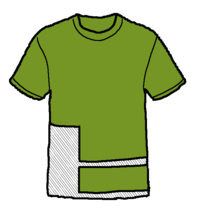 |
 |
A T-shirt mask with no sewing
Use scissors to cut a t-shirt (front and back layers at the same time) to make a larger center piece with straps, as shown.
The four strap pieces should measure about 30 cm (12 inches) long by 3 cm (1 inch) wide, and are used to tie the mask around your head. The rectangle is cut to measure 20 cm (8 inches) wide by 35 cm (14 inches) tall, so after the top flap is folded down, the mask will measure 20 cm (8 inches) wide by 17.5 cm (7 inches) tall.
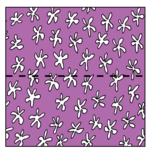 |
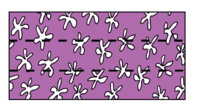 |
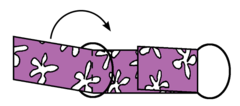 | |
A handkerchief or bandana mask with no sewing
Although they do not protect as well as a T-shirt mask, you can make a simple mask with a large handkerchief or bandana.
Fold in half, then fold the top third down and the bottom third up.
Add 2 rubber bands or hair ties, and fold each end toward the center.
Tuck the ends into each other. Put the cloth on your face, hook the rubber bands behind your ears, and spread the cloth to fully cover your nose and chin.
A simple mask to sew

Cut two pieces of cloth 25 cm by 15 cm (10 inches by 6 inches). Place one on top of the other so you have two layers of cloth.
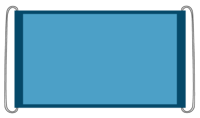
Hem the long sides by folding each one over 1 cm (¼ inch) and sewing them down.
Fold the short sides over 1.5 cm (½inch) and sew them, leaving space for strings or elastic to be threaded through.
Thread strings or elastic through each side with a large needle or bobby pin. Make them into loops that go over your ears to hold the mask. Or you can use longer strings to tie the mask behind your head instead of over your ears.
How to make a face shield

The virus in droplets can enter the body through the eyes. This face shield made from a 2-liter soda bottle protects the face and eyes. Because it doesn’t fit closely around the mouth and nose, it isn’t good protection for breathing, so wear a mask under it. If you are working with deaf or hard-of-hearing people, use the shield without a mask so they can read your lips.
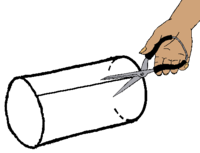
Use an uncolored, clear bottle with straight sides.
Cut off the bottom near the base, and the top near the opening.
Cut from top to bottom. Cut some off of each side so the shield does not cover your ears, and trim the corners to make them rounded.
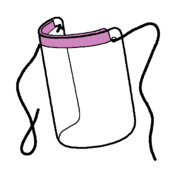
Glue a pad, such as pieces of sponge or rolled-up cloth, onto the top of the shield for your forehead. This increases comfort and stops droplets from entering the face shield from above.
Punch or burn a hole through the two upper corners, and tie some string or cloth strips through to hold the face shield on.
To keep your breath from fogging up the face shield, mix a spoonful of detergent in a bowl of water and dip the shield in it. Let it dry before you put it on. Remember to clean the face shield often.
How to make a foot-pedal hand-wash station

Soap and other options for cleaning hands
Washing hands with soap and water is an important way to prevent illness, including COVID-19. Any soap or detergent for washing the body, hair, clothing or dishes can be used to wash your hands. It can be solid, liquid, powder or paste.
If you have nothing else, use ashes, sand, or mud. Rub hands together as if you were using soap and rinse well. Or you can make:
Crude soap: Throw one or two handfuls of ash from a hardwood fire into a pan with leftover grease still warm from cooking. Mix together well.
Alcohol-based hand rub: Mix 2 parts isopropyl or rubbing alcohol (99% alcohol) with 1 part water, aloe vera gel (from the inside of the leaves), or glycerol.
Bleach-based hand wash: Mix 34 parts water to 1 part 3.5% household bleach (3 teaspoons of bleach in ½ liter of water), or 52 parts water to 1 part 5.25% bleach (2 teaspoons of bleach in ½ liter of water). Try not to use this very often and rinse with water after using because this may hurt your skin.
How to make soap
To make 4 kilos (9 pounds) of soap you will need:
- Vegetable oil or fat—3 liters (13 cups) of oil or 2.75 kilos (6 pounds) of hard fat. Different oils and fats will give different results. Experiment with what is available.
- Lye—370 grams (13 ounces). Lye is also called caustic soda or sodium hydroxide, and can often be found at a pharmacy.
- Water—1.2 liters (5 cups). It must be “soft” water, such as rain or spring water. To “soften” hard water (well or river water), add ¼ teaspoon of lye for each liter of water. Stir and let sit for a few days. Solids will sink to the bottom. Pour off the softened water for use.
Using dirty or rancid fat
Dirty oil or rancid fat can be used to make soap, but must be cleaned first. To clean, pour the oil or fat into an equal amount of water and bring to a boil. Let it cool, and skim off the oil or fat. If it still smells bad, do it again with new water. If the oil or fat has dirt in it, melt it and pour it through a fine cloth until it is clean.
Perfume
Perfume or essential oils give soap a pleasant smell. For 4 kilos of soap, use one of the following: 4 teaspoons of sassafras oil, 2 teaspoons of citronella or lavender oil, or 1 teaspoon of clove or lemon oil. For soap that promotes healthy skin, add 1 or 2 teaspoons of oil of neem, moringa, jatropha, or baobab or oils people in your community use to protect the skin.
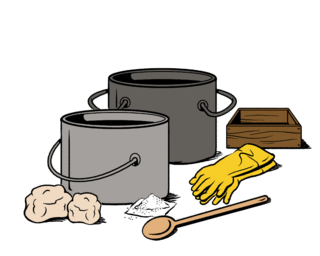
Equipment
- 2 large pots, bowls, or buckets made of stainless steel, fired clay, or cast iron (not aluminum).
- A bowl or other clean container big enough to hold the fat.
- Wooden spoons or stirring sticks.
- Measuring cups.
- An accurate weighing scale (lye must be weighed).
- Molds. The best molds are shallow wooden boxes that can be pulled apart gently to get the soap out. Small gourds and coconut shells also work.
- Use cloth, waxed paper, or a large flexible leaf to line the molds to make removing the soap easier.
Recipe
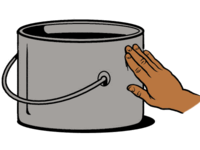
- Add lye to water – never the other way around. The mixture will heat by itself. Wait for it to cool to a temperature that is warm, not hot. Do not put fingers in the solution – it will burn. To test the temperature, feel the outside of the container.
- Heat the oil or oil/fat mixture so it is warm, not hot, and the fat has melted.
- Pour the lye water slowly into the oil/fat mixture, stirring it constantly in one direction. Then add perfume or essential oil. Stir the mixture for at least half an hour after all the lye water has been added. The mixture will thicken and when the spoon causes lines to appear on top, it is ready to pour into the molds.
- Pour the mixture into lined molds and leave to set undisturbed for 2 days. If it has not set or if it has grease on top, leave it longer.
- When the soap has set, remove it from the molds and cut it into bars using a knife or a wire.
- Stack the bars on trays and let them sit for 4 to 6 weeks. Do not use the soap too soon – it still burns!
- When the soap is finished, you can shave it from the bar in curls. Touch the soap to the tip of your tongue to check its quality. If it has a slight bite or burn, it is good. Cover the soap so it does not lose moisture.
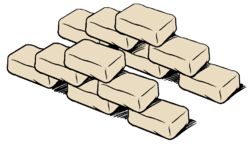

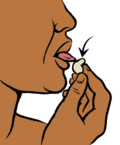
Problems?
If it still tastes too sharp and burns the tongue, there is too much lye. If it has no bite, there is not enough lye.
If the soap you made was not successful, you can fix it by remaking it:
- Cut the soap into bits, using gloves. Put it in a pot with 12 cups (2.8 liters) of water.
- Bring it slowly to a boil. Boil for 10 minutes, stirring at times.
- If the soap had too little lye (no bite), add a small amount of lye. If the soap had too much lye (sharp bite), add some fat or oil as you did in step 2. Stir until the spoon makes lines on top of the thick mixture.
- Pour into molds, and let sit as in steps 4 to 6 above.


